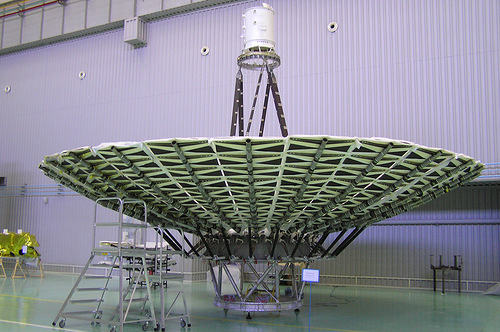The project "Radioastron"
 In the footsteps of the post about the failures of Roscosmos and in stupor on the number of topics about Curiosity
In the footsteps of the post about the failures of Roscosmos and in stupor on the number of topics about CuriosityYesterday I tried to look for something on Habr. Result:
"Curiosity" - 17 topics;
"Phobos-Grunt" - 4 topics.
Radioastron - 0 topics.
(I considered the topics clearly devoted to sabzh.)
Sadly, gentlemen geeks. In that topic about Roscosmos, the idea was expressed that modern Russian technical intelligence doesn’t care about Russian successes - it’s interesting to just poke a finger “but in the West, oooh!” And “lose all polymers, thieves”.
')
Looking at the sad statistics of the search, it is easy to believe. Well, we will correct little by little to the best of our modest forces.
Radioastron is an international project of fundamental space research in the radio range. To implement this project, on July 18, 2011, Spectrum-R was launched into a near-earth orbit - a space observatory representing a 10-meter radio telescope orbiting the Earth in a highly elongated elliptical orbit (perigee - 10,000 km, apogee - 390,000 km, comparable to the distance to the moon).
The project coordinator is the Astro Space Center of FIAN, the device was developed by NPO. Lavochkin, launched into orbit with the help of the Zenit-2 launch vehicle with the Fregat-SB upper stage (also developed by the Lavochkin Scientific and Production Association). The Radioastron project is the only launch of a spacecraft into a high orbit for the entire 2011.
Why do you need a high-orbit radio telescope?
The key characteristic of the telescope is its angular resolution - the minimum angle between two objects, at which they are visible as separate objects in a telescope. The theoretical resolution of the telescope is described by the formula 1.22 λ / D, where λ is the wavelength, D is the diameter of the telescope mirror.
In practice, optical telescopes quickly abut the ceiling, equal to 0.5-1 angular seconds, due to atmospheric scattering. Almost the same resolution has a Hubble telescope.
At radio, the effect of the atmosphere is much smaller, but the wavelength is much longer. Despite the fact that radio telescopes are much larger, the angular resolution of even the largest radio telescope does not exceed 15–20 arc seconds.
However, there is room for maneuver. Since radio waves are long and not scattered by the atmosphere, it is possible to combine several radio telescopes into an interferometer . In this case, the denominator of the formula will no longer be the diameter of the mirror, but the distance between the paired telescopes (the base of the interferometer).
Using a group of radio telescopes located in different parts of the world, it is possible to achieve an angular resolution of the order of one thousand angular seconds (that is, three orders of magnitude better than in the optical range).
But if you bring one end of the interferometer into space, you can get a much larger base of the interferometer than we have on our globe. In the case of Radioastron, the length of this base is 390 thousand kilometers - which corresponds to a resolution in millionths of angular seconds for short waves.
To do this, Radioastron should be synchronized with a number of terrestrial radio telescopes (radio telescopes in Green Bank, Effelberg and Arecibo, as well as a number of Russian and Ukrainian radio telescopes take part in the project). This is an unprecedented technical challenge — the predecessor of RadioAstron, the Japanese eight-meter telescope of the VSOP project, turned in orbit with an apogee of 21,400 kilometers - twenty times closer than Radioastron. The telescope continuously receives 128 megabits of data per second.
It was originally planned that RadioAstron will be in orbit for 5 years (before due to the gravitational pull of the Moon it enters the dense layers of the atmosphere). However, in March of this year. managed to adjust the course of the apparatus and extend its life to 10 years.
We now turn to the most delicious - what is being researched and will be researched using Radioastron. Here is a brief list of the main tasks of the project:
- The study of the nature of the energy source in the nuclei of active galaxies.
- Investigation of the cosmological evolution of compact extragalactic sources.
- The study of the formation of stars and planetary systems.
- The study of pulsars (neutron and strange stars and magnetars).
- Microquasars and radio stars.
- Space ballistics and gravimetry - building a model of the gravitational potential of the Earth and measuring the effects of general relativity.
- Fundamental astrometry - building a new generation of celestial coordinate system.
In addition to the radio telescope, the Space Observatory includes the Plasma-F complex, which explores the Earth’s magnetic field, the solar wind, and predicts magnetic storms.
You can read more about the goals and objectives of the project here:
www.federalspace.ru/main.php?id=148
Source: https://habr.com/ru/post/149959/
All Articles